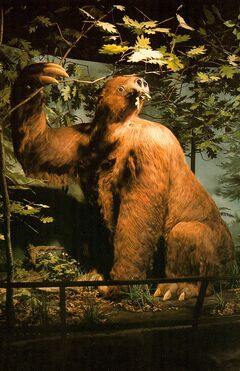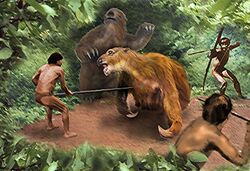
An Iowa reconstruction of the Jefferson's ground sloth, Megalonyx jeffersoni. This model was identified by an eyewitness as the Mapinguari.

The mapinguari imagined as a giant ground sloth by an unknown artist.

Statue showing the mapinguari as a primate.
- This article is UNDER CONSTRUCTION.
- Other names: Mapinguary, cape-lobo, juma, ow-ow, mao de pilao, segamai[1]
- Country reported: Bolivia, Brazil, Ecuador, Paraguay, Peru
The mapinguari is a large cryptid sloth or ape reported from the deepest portions of the Amazon Rainforest. The natives there describe it as a bipedal ape-like animal with long red hair, a foul smell, a single eye, and a mouth in its stomach.[1]
Many cryptozoologists, and some mainstream zoologists including David Oren, who is best known for his research on the mapinguari, believe that it may exist as a relict ground sloth or an undiscovered hominid.[1][2] Like many other cryptids, what is called the "mapinguari" may be two animals, a ground sloth and a great ape.[3]
Etymology
"Mapinguari" is variably translated as "the roaring animal" or "the fetid beast", although this claim seems to originate from Wikipedia and lacks a source. A Spanish-languages website gives the etymology as "defender of the forests".[4]
"Mao de pilao" means "pestle hand" in Portuguese.[1]
Description
Physical evidence
Hair
David Oren has collected several hair samples which he believed may have come from the mapinguari, but testing results were inconclusive, and in one case a tuft of hair he found turned out to come from an agouti.[5]
Tracks
Stool
David Oren has collected several stool samples which he believed may have come from the mapinguari, but testing results were inconclusive, and in one case some fecal matter he found turned out to come from a giant anteater.[5]
Audio recordings
Sightings
Undated
Around the turn of the 20th Century, Percy Fawcett described large footprints being found in the Amazon, and referred to "primeval beasts" being disturbed in swamps.[6] David Oren has collected over ninety accounts of the animal,[7] and as of 2002 had interviewed seven hunters who claimed to have shot specimens.[1][8] In 1994, Oren was attempting to mount an expedition to search for the mapinguari.[8]

A Bullyland Megatherium toy used by Oren to interrogate eyewitnesses.
A native hunter named Manuel Vitorino Pinheiro dos Santos shot four peccaries before hearing the call of the mapinguari. He fled to the river as the second call shook the trees themselves, and hid under the water. The calls became muffled as the animal seemed to move deeper into the jungle, but Manuel remained hiding for hours.[5]
A man named Edinalo worked for an oil company putting pipelines through the Amazon. When he got off his boat onto dry land, he was attacked by a large, smelly, hairy animal which broke his jaw. Overwhelmed by the smell, he blacked out, and was later found by more people. The encounter was so terrifying for him, he quit his job and refused to enter the forest again.[7]
Two men were driving in their car when a mapinguari came out of the forest. They hid, and it moved away.[7]
A Karitiana man named Moaci was out hunting when he saw what he believed was a giant anteater, due to its claws; but when the animal stood up, it was taller than a man. Moaci fled, pursued by the animal, and hid himself under a tree, which the mapinguari attempted to uproot.[9]
Richard Terry's guide Samuel recounted to Terry a story told by his grandfather about a mapinguari encounter in the remote border region between Brazil and Venezuela:
- "He said that he came face to face with an unearthly beast. He was convinced it was the Mapinguari, which had entered his remote cabin at night. It was so large that when it stood upright roaring at him, it lifted the wooden ceiling. Apparently the creature knocked the man to the ground with one powerful lunge of its arm, breaking his jaw. He believes he was only able to save himself having had a gun which he used to fire a round directly into the shaggy haired monster that fled leaving a trail of blood".[10]
A native woman was gathering fruit near her house when she was disturbed by a mapinguari. She fled back to her house.[11].
A native hunter was stalking peccaries when a mapinguari emerged from the trees. The man fled.[11]
A man was cooking dinner inside his hut when the entire straw roof was torn off. He fled outside, only to be attacked by a mapinguari.[11]
1930
In 1930, an explorer named Inocêncio or Inocèncio was exploring the Urubu River with ten friends,[1] but became lost in pursuit of a troop of black monkeys which he intended to shoot.[2][12] He became seperated from his friends and was spending the night in a tree[1] when he was disturbed by what sounded like a man crying out three times, before a large animal approached:
- "Some forty yards away was a small clearing where a samaumeira had fallen, and its branches had brought down other, smaller trees. This was where his last cry had come from. Immediately afterward there was a loud noise of footsteps, as if a large animal was coming at me at top speed. When it reached the fallen tree, it gave a grunt and stopped. Finally, a silhouette the size of a man of middle height appeared in the clearing.
- "It remained where it stood, looking perhaps suspiciously at the place where I was. Then it roared again as before. I could wait no longer and fired without even troubling to take proper aim. There was a savage roar and then a noise of crashing bushes. I was alarmed to see the animal rush growling towards me and I fired a second bullet. The terrifying creature was hit and gave an incredibly swift leap and hid near the old samaumeira. From behind this barricade it gave threatening growls so fiercely that the tree to which I was clinging seemed to shake. I had previously been on jaguar-hunts and taken an active part in them, and I know how savage this cat is when it is run down and at bay. But the roars of the animal that attacked me that night were more terrible and deafening than a jaguar's.
- I loaded my gun again and fearing another attack, fired in the direction of the roaring. The black shape roared again more loudly, but retreated and disappeared ito the depths of the forest. From time to time I could still hear its growl of pain until at last it ceased.
- Dawn was just breaking."[2]
After spending the night in the tree, the next morning Inocêncio disovered broken shrubs, splashes of blood, and a strong, sour smell permeating the whole area.[2]
1937
A 1937 report from central Brazil claimed that a mapinguari had gone on a three-week rampage, killing over 100 cows and ripping out the tongues from their carcasses.
1975
In 1975, a mine worker named Mário Pereira de Souza claimed to have come face to face with a mapinguari in a mining camp in Rio Jamauchim. He heard a screaming noise, and the animal charged at him, unsteadily, on its hind legs.[1]
1977

The mapinguari envisioned as a giant ground sloth by William Rebsamen.
A colleague of David Oren encountered a mapinguari in around 1977.[7]
circa 1980's
One group of Kanamarí Indians living in the Rio Juruá valley claimed to have raised two infant mapinguaris on bananas and milk, but after one or two years their stench became to much to bear, and they were released.[1]
1981
In September 1981, in Valeria, a woman named Lydia was at the edge of the forest near her house at night, when she was startled by by a howling noise. She fled to her father, Teofelo, who grabbed a gun and went to untie his cow. He saw the mapinguari, and shot at it before fleeing back to his house. The next day, all of the villagers moved, and settled by the edge of the river.[7]
1997
Glenn Shepard Jr., an American ethnobiologist and anthropologist based in Manaus, said he was among the skeptics until 1997, when he was doing research about local wildlife among the Machiguenga people of the far western Amazon, in Peru. Tribesmen all mentioned a fearsome slothlike creature called the segamai that inhabited a hilly, forested area in their territory.
Shepard said "the clincher that really blew me away" came when a member of the tribe remarked matter of factly that he had also seen a segamai at the natural history museum in Lima. When Shepard checked, he realised that the museum has a display featuring a model of a giant ground sloth.[13]
circa 1990's
Sometime in the late 1990's Dutch primatologist Marc van Roosmalen heard that a tribe along the river Rio Purus found mapinguari footprints near their settlement, and moved their houses to the other side of the river out of fear. When asked if he believed the mapinguari really existed, Van Roosmalen answered: "I'm not going to say it's not possible," he said. "Who am I to say that?"[1][14]
circa 1993
70-year old Joao Batista Azevedo was working by a river when he heard a mapinguari scream. It came out of the forest, but did not approach or attack him.[15]
2003 or 2004

A different view of the sloth model identified as a mapinguari by Geovaldo.
A Karitiana man named Geovaldo claimed to have encountered a mapinguari in 2003 or 2004 near an area called "the Cave of the Mapinguari", altough he gives conflicting accounts of the sighting. In the first report, he simply said he had seen it and been knocked unconcious by the smell:[13]
- "It was coming toward the village and was making a big noise. It stopped when it got near me, and that’s when the bad smell made me dizzy and tired. I fainted, and when I came to, it was gone."
This account was confirmed by Geovaldo's father Lucas, who said that when his son took him back to the site of the encounter, he saw a cleared pathway where the creature had departed, "as if a boulder had rolled through and knocked down all the trees and vines".[13]
In the very different account given later on Beast Hunter, Geovaldo actually shot the animal. He said he was hunting wild pigs when he was attacked by a mapinguari. He fired at it multiple times before loading his gun with a lead slug, and firing at the animals face. The mapinguari stopped and screamed in pain, and Geovaldo escaped.[7][9]
Interviewed for Destination Truth in 2008, Geovaldo gave an intermediate account; he said that he saw the mapinguari when he went out to hunt, shot at it, and ran off when it charged at him.[9]
Possibly Geovaldo had two seperate encounters with the animal, with the shooting incident occuring later, after July 2007 but before 2008. Additionally, there may have been two Karitiana men named Geovaldo who encountered the mapinguari within the space of a year; which is perhaps not so far-fetched as it sounds, as the first encounter happened near "the Cave of the Mapinguari". A third possibility is that the original New York Times report printed a garbled, mistranslated account of the incident.
2007
A July 2007 report from Rio Branco, Brazil stated that a creature with one eye and a gaping mouth was seen wandering in the deep jungle. The creature was tall, seven feet or more when it stood on two legs, it emitted a strong, extremely disagreeable odor, and it had thick, matted fur.[13]
2014
A group of acai berrypickers in Brazil's Sumaúma Forest Reserve on the Japiim River reported seeing a mapinguari in September 2014. Whilst in a remote area of forest 5 hours away from the nearest village, the harvesters heard a cry:
- "I began to imitate the cry and I realized that the sound was coming to us. That was when we started to hear a loud and intermittent crash. At that moment, a creature of dark color appeared and about two meters high, with only one eye reddish like flames."
The men fled back to the river to spend the night in their tent, but the creature appeared again, and they returned to their village in their canoe during the night, abandoning their equipment. Some of the men could not sleep for days, and as of October 2014, none of the people of the village had dared return to the forest.[16]
Expeditions
2001
2008 (Destination Truth)
In a 2008 investigation for Destination Truth, Josh Gates travelled to the Amazon to interview eyewitnesses, including Geovaldo. He and his team carried out a nighttime investigation, where they heard the snapping of trees, and found torn-apart palm trees. They also recorded an animal call which a former Los Angeles zookeeper was unable to identify.[9]
2011 (Beast Man)
Pat Spain's 2011 investigation came up with evidence of the Mapinguari being a giant sloth. He blasted a call and got a respose; both calls sounded like deeper sloth shrieks. He interviewed Geovaldo, who identified the animal he saw as a giant sloth.[7]
2011 (Man v. Monster)
An investigation by Richard Terry found a large shape on the night-vision camera. The animal was unable to be identified.[11]
Theories
Mistaken identity
Unknown hominid
Giant ground sloth
Since the 1990's, the most common theory regarding the identity of the mapinguari is that it is a giant ground sloth, a diverse family of mammals that lived from the Oligocene to the Early Holocene, for millions of years. Mylodon, Glossotherium and Megatherium are the three giant sloths variably named as the culprit, although Megatherium's immense size is not consistent with the more conservative size reported in mapinguari encounters.

A fossil replica of Megatherium, one of the largest mammals, at the Natural History Museum.
This theory is backed up by a number of facts. A member of a tribe visited by Glenn Shepard Jr., claimed that a museum he had visitied had a model of a segamai; Shepard checked, and the museum had a model of a giant ground sloth.
In Pat Spain's investigation, a slowed-down sloth call was blasted in the rainforest. Pat got a vocal response which sounded similar to his modified sloth call; a large sloth would sound like a slower, deeper normal sloth.[7] Glossotherium also had large ear ossicles, suggesting that it was adapted for long-range communication.[17] This makes Glossotherium the most likely culprit.
In Spain's investigation, eyewitness Geovaldo was shown images of various animals, both South American and African. Geovaldo identified the South American animals, but not the African ones, as would be expected. When an image of a ground sloth was shown, Geovaldo identified it as what he had seen.[7]
Similar cryptids
- The curupira, a cryptid primate of the Amazon, also described as having shaggy red hair and backwards feet.
- The didi, a large cryptid hominid or ape of the Amazon.
- The Ecuadorean ground sloth.
- The Mono Grande, a large cryptid hominid or ape of the Amazon.
- The pé de garrafa, a "bottle-footed" cryptid primate of the Brazilian Amazon.
- The segamai, a cryptid sloth of the Peruvian Amazon, equated with the sloth-form of the mapinguari by authors including George Eberhart and the New York Times.
- The sisemité of Central America, a cryptid usually described as a dark shaggy humanoid, although one eyewitness thought it looked like a ground sloth.
- The ujea, another ground sloth-like cryptid reported from Ecuador.
Further cryptozoological reading
Notes and references
- ↑ 1.0 1.1 1.2 1.3 1.4 1.5 1.6 1.7 1.8 1.9 Eberhart, George (2002) Mysterious Creatures: A Guide to Cryptozoology
- ↑ 2.0 2.1 2.2 2.3 Heuvelmans, Bernard (1955) On the Track of Unknown Animals
- ↑ Coleman, Loren & Clark, Jerome (1999) Cryptozoology A to Z
- ↑ Mapinguari, el perezoso gigante del Amazonas | La Opinión
- ↑ 5.0 5.1 5.2 Beasts in the Mist | DiscoverMagazine.com
- ↑ Fawcett, Brian & Fawcett, Percy (1953) Exploration Fawcett
- ↑ 7.0 7.1 7.2 7.3 7.4 7.5 7.6 7.7 7.8 Beast Man: Nightmare of the Amazon
- ↑ 8.0 8.1 Shuker, Karl (2010) Karl Shuker's Alien Zoo: From the Pages of Fortean Times
- ↑ 9.0 9.1 9.2 9.3 Destination Truth: Flying Dinosaur/Sloth Monster
- ↑ Cryptomundo >> Man v. Monster: Brazilian Bigfoot on Nat Geo Wild Tonight!
- ↑ 11.0 11.1 11.2 11.3 Man V Monster: Brazilian Bigfoot
- ↑ Redfern, Nick (2015) The Bigfoot Book: The Encyclopedia of Sasquatch, Yeti and Cryptid Primates
- ↑ 13.0 13.1 13.2 13.3 The New York Times - A Huge Amazon Monster Is Only A Myth. Or Is It?
- ↑ Amazon Primatologist Shakes Family Tree For New Monkeys, Chicago Tribune, 11 June 199
- ↑ Bigfoot of the Amazon: The Mapinguari - Jungle Blog - Rainforest Cruises
- ↑ Catadores de acai afirmam ter visto um Mapinguari - Jornal O NORTAO
- ↑ Taylor & Francis Online :: Estimation of hearing capabilities of Pleistocene ground sloths (Mammalia, Xenarthra) from middle-ear anatomy - Journal of Vertebrate Palaeontology - Volume 28, Issue 1
